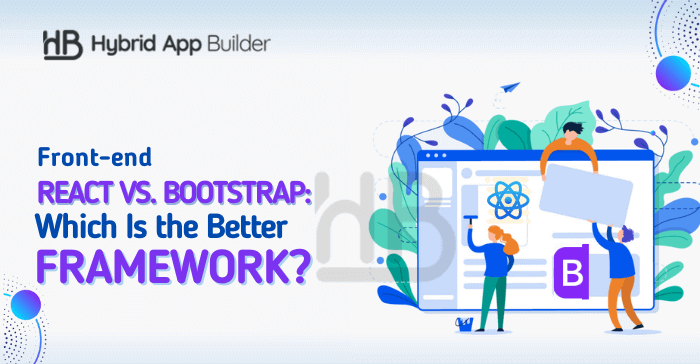
Keeping up with the most recent front-end frameworks is essential in the always-changing world of web development. As technology advances rapidly, developers seek efficient solutions that empower them to create stunning websites and applications.
Among the plethora of available options, two front-end frameworks have garnered significant attention and become dominant forces in the industry: Bootstrap & React. In this blog, we will analyze their features, benefits, drawbacks, and applications to know Bootstrap vs React which is better.
Understanding Bootstrap
Before we delve deeper into the debate of “Is React better than Bootstrap?” Let’s first explore how the development of Bootstrap took place.
The developers at Twitter created Bootstrap in 2010. And today, it has emerged as one of the most popular front-end frameworks that offer a selection of pre-built elements and styles. Its primary focus is on responsive design and mobile-first development.
Since its inception, Bootstrap has empowered developers to create visually appealing websites rapidly. It is leveraging its grid system, typography, forms, and numerous UI components. Its widespread use and thorough documentation contribute to its popularity and make it an excellent option for developers of all experience levels.
Exploring React
On the other side, Facebook maintains React. It is a reliable and robust JavaScript library used to create user interfaces. Bootstrap and React’s key difference lies in their front-end development approaches.
Contrary to Bootstrap, React employs a component-based methodology in which the user interface divides into independent and reusable components. Modularity lets developers build complex applications easily by individually managing and reusing components.
React uses a virtual DOM to effectively update only the relevant components of the user interface, improving efficiency. It has gained immense popularity within the development community due to its flexibility, performance, and extensive ecosystem.
Difference between Bootstrap and React
Now that we have understood the primary definition, it’s time to delve into the heated debate of Bootstrap vs React, which is better. We will differentiate these two front-end frameworks on various features and their utilities.
User Interface Development
Bootstrap: With its pre-designed components and styles, Bootstrap simplifies UI development. Its responsive grid system and extensive CSS framework classes make it effortless to create visually appealing layouts.
React: React is built on a component-based design so that developers can create dynamic, interactive user experiences. It offers reusable components, making maintaining and updating UI elements easier.
Performance
Next, in the debate of Bootstrap vs React, we will analyze the performance of both frameworks.
Bootstrap: Bootstrap optimizes performance as a CSS-based framework, achieving faster rendering and loading times through minimal JavaScript requirements.
React: The virtual DOM of React effectively updates only the components that are required, speeding up rendering and improving performance. It excels at managing complex data flows in large-scale applications.
Customization
Bootstrap: While Bootstrap offers various customization options, modifying its default styles can be challenging. To get the intended look and feel, developers frequently override pre-existing styles.
React: React allows developers to customize every aspect of the UI. It is a crucial advantage of using React in the battle of Bootstrap vs React. It will enable the creation of unique user interface designs without being constrained by predefined styles.
Learning Curve
Bootstrap: Thanks to its extensive documentation and vast community support, Bootstrap is relatively easy to learn. Its fundamentals are simple for developers to comprehend, and they may get to work fast creating websites.
React: The learning curve for React is higher, especially for people who are unfamiliar with JavaScript frameworks. However, once the fundamentals are understood, React’s component-based approach becomes intuitive and enhances development speed.
Use Cases
In Bootstrap vs React, Bootstrap is an ideal choice for projects prioritizing rapid development, such as landing pages, marketing websites, or simple web applications. Its wide range of pre-designed components and responsive grid system makes it perfect for quickly prototyping and building visually appealing websites.
In increasingly complicated situations, React excels, especially when creating expansive apps with dynamic user interfaces. React’s component reusability and performance optimizations make it an excellent choice for creating interactive and responsive user interfaces.
Is React better than Bootstrap a matter of Personal Preference?
The best front-end framework you choose for your project can make a big difference in its success in web development. Bootstrap & React have established themselves as two prominent contenders among the myriad options available. But is there a difference between both frameworks or is it just a matter of personal preference?
In this thought-provoking article, we will explore the key factors that differentiate Bootstrap and React, helping you navigate through the complexities of these frameworks. While personal preference undoubtedly plays a role in framework selection, analyzing each framework’s objective advantages and use cases is essential. By shedding light on their unique features and characteristics, we aim to provide you with the necessary insights to make an informed choice for your front-end development endeavors.
Wrap Up
Both frameworks, in comparison to Bootstrap vs React, have advantages and disadvantages. Bootstrap offers simplicity, ease of use, and a rich collection of pre-designed components, making it an excellent choice for rapid development. React provides flexibility, modularity, and optimized performance.
The type and objectives of your web development project will ultimately determine which framework you use, either Bootstrap or React. By carefully considering the specific requirements, scalability, and desired user experience, you can make an informed decision that aligns with your development team’s expertise and project objectives.
